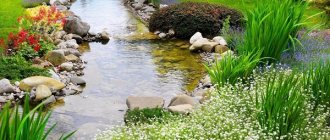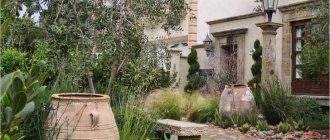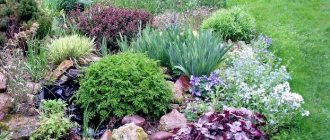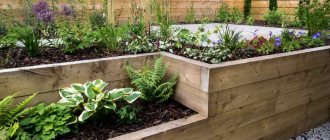In order to successfully select plants for landscaping your garden plot, you need to take into account the climatic conditions of the region, the terrain, the presence of buildings, the degree of soil moisture, problem areas, as well as the style in which you would like to perceive your landscape design option.
In addition, when choosing plants, it is necessary to take into account their natural habitats, in what conditions they feel great, so as not to make a mistake in the choice and make your landscape design not only spectacular, but also viable.
Types of astilbe by height
You can choose unpretentious plants that are undemanding to living conditions. Such plants, used to decorate a wide variety of landscape design styles, include numerous varieties of astilbe.
According to the height of astilbe there are:
- dwarf – up to 30 cm high;
- short - from 30 to 60 cm;
- medium height – up to 90 cm;
- tall, up to 150 cm high.
Astilbe grows wild in China, Mongolia, Japan, and North America.
In natural conditions, approximately 30 species of this plant are known. Thanks to the work of breeders, many varieties and hybrids have been developed that differ in color, size, and flowering time. In landscape design, bred varieties of various shades of pink, lilac, as well as white and cream are used; astilbes also differ in size and shape of flowers. In total there are from 200 to 300 varieties and hybrids.
Different varieties of astilbe bloom at different times, starting in June and ending at the end of August. Using this, you can create a composition in landscape design that will bring you joy with flowering throughout the summer.
Types of inflorescences
Astilbes also differ in the shape of their inflorescences; in total there are 4 types of inflorescences:
Pyramidal - resemble a regular pyramid in shape, decreasing from the base to the apex, the lateral inflorescences emerge almost at a right angle to the central inflorescence, and then converge at the apex;
Rhombic (geometrically similar to a rhombus) - lateral inflorescences form an acute angle with the main one. This is the form of inflorescence of Japanese astilbe;
Paniculate in shape (found in Arends' astilbe) - multiple branches with a large number of branches extend from the base at an acute angle and taper towards the apex;
Drooping form (Astilbe Thunberg and Lemoine) - inflorescences with flexible drooping racemes in the form of beautiful hanging arches.
The use of astilbe in landscape design
How to use astilbe in landscape design is determined by the style in which the garden plot is intended to be decorated. It will decorate the garden throughout the entire period of development, from the appearance of the first leaves in the spring to the complete drying of the plant in the fall. Astilbe in landscape design is interesting not only during the flowering period (photo); the leaves also have a decorative appearance.
In landscape design, you will be pleasantly surprised by the beautiful purple color of the emerging leaves; as they grow, they acquire a traditional green color, but of an unusual shape, as if carved. It is advantageous to use in the design of any composition - flowering lasts for at least a month, during which time you will have time to enjoy both the color and shape of the flowers. The colors of the flowers are pleasant soft colors, a whole range of pink and lilac shades, white and cream specimens look impressive.
Planting in groups
These flowers can be planted in the landscape as individual specimens and groups, and different colors and sizes can be combined in the design.
Astilbe can be planted in any flower garden; it will fit well into your chosen landscape design option due to its versatility. Due to the ability to use plants of different heights, astilbe can be planted both in the first rows of a flower garden and in the middle or background of the design. It is appropriate to fit low-growing species into a landscape design on an alpine hill. Tall ones will find use for decorating unsightly areas of landscape design, for example, they will be an excellent option for a green hedge and will hide outbuildings from prying eyes. In the design, you can place flowers along the paths, singly or in groups.
Planting in flower beds
Low-growing varieties are used as landscape decoration for borders in flower beds and lawns. If you plant an astilbe bush in a flower pot, it will serve as a decoration for the design of an open veranda or garden gazebo.
Neighboring flowers for astilbe
Astilbe harmonizes in landscape combination with other garden plants, easily fits into the design with conifers, for example, thujas, junipers, and looks great together with hostas and ferns. A good combination would be openwork leaves of astilbe and large whole leaves of hellebore, bergenia, podophyllum, Rogers, mantle. To decorate landscape design, it is planted next to daylilies, aquilegia, ferns, lilies, phlox, and geraniums.
It is possible to create an interesting design if you use a landscape combination of astilbe with spring-blooming perennials, such as saxifrage, tenacious, and jasmine. In early spring, while the astilbe is growing, its neighbors will create a decorative landscape design, and after they fade, it will take on the accent in the flower arrangement. Astilbe is planted in the spring garden along with snowdrops, crocuses, tulips, lilies of the valley, and rhododendrons.
Astilbe will make good company with flowers whose lower part is exposed; thanks to its abundant decorative foliage, it will help hide the shortcomings of such neighbors. It grows well in shady places, under trees, in the shade of houses, diluting the greenery of shade-loving plants with its beautiful flowers. It is usually quite difficult to choose a flowering plant that will thrive in the absence of sunlight; astilbe will help you solve this landscape design problem.
Advice! When planting it under trees, retreat 1.5 - 2 meters from the tree trunk so as not to damage the roots of the tree and not weaken the growth of astilbe.
Tandem with juniper
Against the background of coniferous juniper, astilbe looks especially elegant, attracting the eye and being a bright accent in the composition.
Examples of design of naturgardens and park areas.
Astilbe is one of those flowering perennials that does not require complex care and, most importantly, can survive cold winters in open ground. No wonder this beautiful plant is deservedly popular among gardeners and landscape designers.
- Author: Ilona Lukina
Rate this article:
- 5
- 4
- 3
- 2
- 1
(33 votes, average: 4.2 out of 5)
Share with your friends!
How to choose a place for astilbe
If planted in sunny locations, flowering will be reduced to about two weeks, and the flowers may fade in the sun. If you want to use this plant in landscape design in places exposed to the sun, it is better to choose varieties adapted for this, for example, Chinese dwarf astilbe, varieties Strausfeder, Diamant, Frida Clapp. Astilbe needs a sufficient amount of moisture; in arid areas or during dry summers, additional watering must be taken care of. In very dry climates you may need to water it daily.
Astilbe loves damp places in the garden; it will look great on the banks of reservoirs, either as single plants or planted along the coastline. If you are planning to include a pond in your landscape design, for example, a stream or an artificial lake, it is appropriate to use astilbe for landscaping the coastal zone.
This perennial will also feel good in wetlands, lowlands and places with excessively moist soil. If there is sufficient soil moisture in the spring, you can feed astilbe with mineral fertilizers with the addition of nitrogen components, and after flowering with phosphorus and potassium fertilizers. In dry soil, it is better to avoid mineral fertilizers, replacing them with compost and mulching with peat.
Dividing the bush
This method is the most familiar and widespread among gardeners. First, you need to dig up the bush and cut off all the leaves.
It is very important to do this, since if you leave any extra leaves, they will interfere with the proper propagation of the plant. It is necessary to divide the bush into parts so that each has 3-5 buds.
If a dead rhizome is found, it should be destroyed immediately. Then, you should plant the parts of the plant at an approximate distance of 20-30 centimeters from each other.
Be careful to maintain a favorable environment for the plants. It is advisable that the weather be sunny. Daily watering is also required.
Astilbe care
Astilbe is unpretentious and will grow in any soil; if there are options to choose from, it is better to prefer light, slightly acidic soils, if possible with organic fertilizers. This will promote better growth and abundant flowering of the plant. If it is not possible to mulch the soil with peat or compost, other options are also suitable; you can use last year's dried shoots of astilbe itself.
For your information! The plant is hardy and frost-resistant, does not freeze even in severe frosts, almost does not get sick, and does not require excessive efforts to care for it.
Since it is perennial, there will be no need to plant new specimens every year. It practically does not require shelter for the winter, does not freeze, and also grows quickly, which will allow you to use your planting material for the further propagation of this wonderful plant.
The undeniable advantages of astilbe include its availability for purchase by everyone. The most convenient way to propagate it is by dividing the bushes; this is the most popular method, not labor-intensive and with a high survival rate of the plant. In addition, cuttings of the species you like can be ordered by mail. Even when the cuttings dry out, if suddenly your package is delayed on the road, you can bring them back to life by soaking them for a day in a solution of epin, a growth stimulant, and then planting them in the ground.
This plant can decorate your landscape design even in winter. If you do not cut it after flowering, it retains its decorative appearance throughout the winter; this property of astilbe is used in low-snow regions of Western Europe and North America.
Astilbe also looks good when dried; it retains the richness of its colors and is used to create compositions from dried flowers, both independently and with other plants.
Planting and propagation
When choosing a place for planting, be sure to consider the flowering time of a particular variety. July species love secluded corners in the shade, and early or late species tolerate the sun normally.
For planting, it is important to choose the right rhizome without rotting, dead or damaged parts. It must be healthy, not too dry and not too wet. The quality of the planting material primarily determines how thick, fluffy and beautiful astilbe will grow.
Photo: gardenersworld.com
The distance between seedlings depends on the variety and its size: tall shrubs cannot be planted closer than every 50 cm, and for low ones 30 cm is enough. The depth of the hole also depends on the size: the rhizome should be located freely in it.
Make sure that the growing point is on the surface and not covered with soil. To retain moisture and improve the soil, but not harm the flower, use mineral fertilizers, bone meal, ash and hydrogel. Over the course of a year, astilbe stretches several centimeters, so the opening part of the rhizome must be covered with soil in time.
Seed propagation is not used for perennial ornamental varieties - it is not effective enough. The most reliable, simple and proven method is to divide the rhizome of the dug out mother bush into several parts. And in the spring you can use buds and cuttings - they take root easily and grow quickly.
Photo: agrogarden.ru











